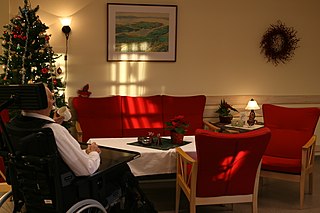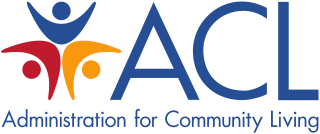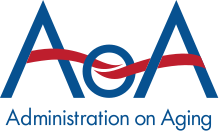
The United States Department of Health and Human Services (HHS) is a cabinet-level executive branch department of the U.S. federal government created to protect the health of the U.S. people and providing essential human services. Its motto is "Improving the health, safety, and well-being of America". Before the separate federal Department of Education was created in 1979, it was called the Department of Health, Education, and Welfare (HEW).
The Substance Abuse and Mental Health Services Administration is a branch of the U.S. Department of Health and Human Services. SAMHSA is charged with improving the quality and availability of treatment and rehabilitative services in order to reduce illness, death, disability, and the cost to society resulting from substance abuse and mental illnesses. The Administrator of SAMHSA reports directly to the Secretary of the U.S. Department of Health and Human Services. SAMHSA's headquarters building is located outside of Rockville, Maryland.
A block grant is a grant-in-aid of a specified amount from a larger government to a smaller regional government body. Block grants have less oversight from the larger government and provide flexibility to each subsidiary government body in terms of designing and implementing programs. Block grants, categorical grants, and general revenue sharing are three types of federal government grants-in-aid programs.

The Children's Health Insurance Program (CHIP) – formerly known as the State Children's Health Insurance Program (SCHIP) – is a program administered by the United States Department of Health and Human Services that provides matching funds to states for health insurance to families with children. The program was designed to cover uninsured children in families with incomes that are modest but too high to qualify for Medicaid. The program was passed into law as part of the Balanced Budget Act of 1997, and the statutory authority for CHIP is under title XXI of the Social Security Act.

The Medical Reserve Corps (MRC) is a network in the U.S. of community-based units initiated and established by local organizations aimed to meet the public health needs of their communities. It is sponsored by the Administration for Strategic Preparedness and Response (ASPR) of the United States Department of Health and Human Services (HHS). The MRC consists of medical and non-medical volunteers who contribute to local health initiatives, such as activities meeting the Surgeon General's priorities for public health, and supplement existing response capabilities in time of emergency. The MRC provides the structure necessary to pre-identify, credential, train, and activate medical and public health volunteers.
The Administration for Children and Families (ACF) is a division of the United States Department of Health and Human Services (HHS). It is headed by the Assistant Secretary of Health and Human Services for Children and Families. It has a $49 billion budget for 60 programs that target children, youth and families. These programs include assistance with welfare, child support enforcement, adoption assistance, foster care, child care, and child abuse. The agency employs approximately 1,700 staff, including 1,200 federal employees and 500 contractors, where 60% are based in Washington, DC, with the remaining in regional offices located in Boston, New York City, Philadelphia, Atlanta, Chicago, Dallas, Kansas City, Denver, San Francisco, Missouri and Seattle.

The Community Planning and Development agency within the United States Department of Housing and Urban Development (HUD) administers the grant programs that help communities plan and finance their growth and development, increase their capacity to govern, and provide shelter and services for homeless people. HUD is a national program, and HUD provides funding directly to larger cities and counties, and for smaller cities and counties, generally to state government. HUD's programs include the Community Development Block Grant Program and the HOME program.

Long-term care (LTC) is a variety of services which help meet both the medical and non-medical needs of people with a chronic illness or disability who cannot care for themselves for long periods. Long-term care is focused on individualized and coordinated services that promote independence, maximize patients' quality of life, and meet patients' needs over a period of time.
The Low Income Home Energy Assistance Program is a United States federal social services program first established in 1981 and funded annually through Congressional appropriations. The mission of LIHEAP is to assist low income households, particularly those with the lowest incomes that pay a high proportion of household income for home energy, primarily in meeting their immediate home energy needs. The program, part of the United States Department of Health and Human Services (HHS), is funded by grants appropriated from the federal government.
The Community Services Block Grant (CSBG) provides federal funding for Community Action Agencies (CAAs) and other programs that seek to address poverty at the community level. Like other block grants, CSBG funds are allocated to the states and other jurisdictions through a formula, with less federal oversight and fewer federal requirements than categorical grants. The CSBG formula determines each jurisdiction's funding level based on poverty population; once disbursed, most of the money is passed by the states and other jurisdictions to CAAs and other designated organizations to be spent on employment, education, income management, housing, nutrition, emergency services, and health.
The HIV/AIDS Bureau is a part of the Health Resources and Services Administration (HRSA), an agency of the United States Department of Health and Human Services. It was established to deal with the growing problem of HIV/AIDS in the United States since the early 1980s.
The Healthcare Systems Bureau is part of the Health Resources and Services Administration (HRSA), of the United States Department of Health and Human Services.
The Family Planning Services and Population Research Act of 1970 is the only federal grant program dedicated to providing individuals with comprehensive family planning and related preventive health services. It was signed into law under President Richard Nixon on December 24, 1970.

The Older Americans Act of 1965 was the first federal level initiative aimed at providing comprehensive services for older adults. It created the National Aging Network comprising the Administration on Aging on the federal level, State Units on Aging at the state level, and Area Agencies on Aging at the local level. The network provides funding—based primarily on the percentage of an area's population 60 and older—for nutrition and supportive home and community-based services, disease prevention/health promotion services, elder rights programs, the National Family Caregiver Support Program, and the Native American Caregiver Support Program.

Kathy J. Greenlee was appointed by U.S. President Barack Obama as the fourth Assistant Secretary for Aging at the U.S. Department of Health and Human Services and confirmed by the Senate in June 2009.
Assistive Technology Acts provide federal funding from the U.S. Department of Education to each state and territory to support "State efforts to improve the provision of assistive technology to individuals with disabilities of all ages through comprehensive statewide programs of technology-related assistance." Assistive Technologies are equipment, items or devices used to improve or keep the functionality of an individual with a disability. This will allow an individual with a disability to be more independent in life, this includes: education, recreation, and any daily activity. The services being offered for Assistive Technology include being able to use AT devices, assessment for the devices, and any maintenance included, such as customization, repair, and training. Under the Assistive Technology laws, federal grants are granted to each state to fund an Assistive Technology Act Project (ATAP) which provide services for individuals with disabilities, their families, guardians and more for their life span. The act, first passed in 1988, expires each years and needs to be continuously renewed to ensure the services can still be used.

The Pandemic and All-Hazards Preparedness Reauthorization Act of 2013 is a law enacted by the 113th United States Congress. The Act amends the Public Health Service Act in order to extend, fund, and improve several programs designed to prepare the United States and health professionals in the event of a pandemic, epidemic, or biological, chemical, radiological, or nuclear accident or attack. The Act clarifies the authority of different American officials, makes it easier to temporarily reassign personnel to respond to emergency situations, and alters the process for testing and producing medical countermeasures. The Act is focused on improving preparedness for any public health emergency.
The Office of the Assistant Secretary for Planning and Evaluation (ASPE) is the principal advisory group to the United States Secretary of the Department of Health and Human Services (HHS) on policy development and provides coordination and support for HHS's strategic and policy planning, planning and development of legislation, program evaluation, data gathering, policy-related research, and regulatory program.
As of 2017, approximately 1.4 million Americans live in a nursing home, two-thirds of whom rely on Medicaid to pay for their care. Residential nursing facilities receive Medicaid federal funding and approvals through a state health department. These facilities may be overseen by various types of state agency.

The Administration for Community Living (ACL) is part of the United States Department of Health and Human Services. It is headed by the Administrator and Assistant Secretary for Aging, who reports directly to the Secretary of Health and Human Services (HHS). ACL's Principal Deputy Administrator serves as Senior Advisor to the HHS Secretary for Disability Policy.









